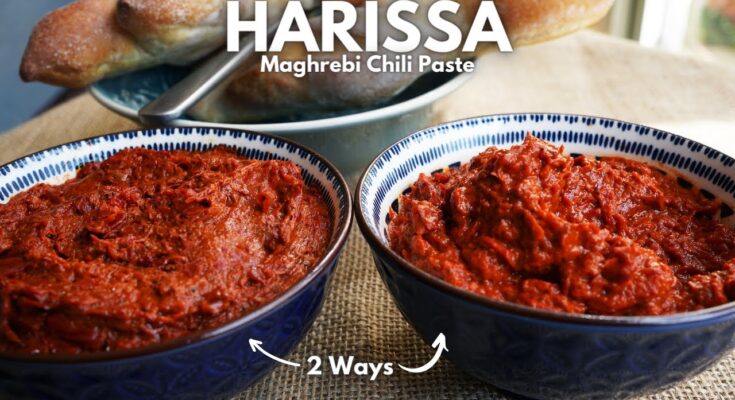Harissa Recipe: Harissa is more than just a spicy paste—it’s a flavor-packed punch from North Africa that’s as versatile as it is vibrant. Think of it as a bold, fiery cousin of your favorite hot sauce, but with layers of complexity. Made from dried chilies, garlic, spices, and olive oil, harissa delivers a smoky, spicy, and slightly sweet taste that lingers on the palate. It’s the kind of condiment that transforms a bland meal into a culinary experience with just a spoonful.
Origins and Cultural Significance
Harissa hails from Tunisia but is widely loved across North African countries like Morocco, Algeria, and Libya. It’s not just a sauce; it’s a cultural icon. Traditionally used in couscous, stews, and grilled meats, harissa’s popularity has spread to Europe and beyond thanks to global palates craving authentic spice blends. In Tunisia, no kitchen is complete without a jar of harissa—it’s the backbone of many meals and a symbol of hospitality and heritage.
Ingredients for Traditional Harissa
Essential Spices and Peppers
To make harissa from scratch, you’ll need a few core ingredients. Start with dried red chilies like New Mexico, Guajillo, or Arbol for a mix of heat and smokiness. You’ll also need:
- 3 oz dried chilies (about 8–10 medium pods)
- 4 garlic cloves
- 1 tsp ground cumin
- 1 tsp ground coriander
- 1 tsp caraway seeds (optional but authentic)
- 2 tbsp tomato paste (for richness)
- 2–4 tbsp olive oil (to bind and preserve)
These spices create that unmistakable warmth and aroma. Caraway, in particular, gives harissa a slightly nutty and earthy taste that balances the heat perfectly.
Optional Add-ins for Variation
Harissa is flexible. Want it smokier? Add smoked paprika. Prefer a sweeter profile? Toss in some roasted red bell peppers. Other optional ingredients include:
- Lemon juice or zest (for brightness)
- Vinegar (for tang)
- Roasted garlic (for depth)
- Mint or preserved lemon (for Moroccan flair)
The beauty of homemade harissa lies in customization—once you’ve nailed the base, you can tweak it to fit your flavor profile like a glove.
Tools You’ll Need to Make Harissa
Kitchen Equipment Checklist
Making harissa doesn’t require a Michelin-star kitchen. You’ll need:
- A bowl (for soaking the chilies)
- A pan (to toast the spices)
- A blender or food processor (for blending everything)
- A spatula (for scraping the paste)
- A jar with a lid (for storage)
If you’re going the old-school route, a mortar and pestle will give your harissa a rustic texture that’s closer to traditional methods. But modern tools like a food processor make the process faster and easier, especially if you’re batch-making.
Step-by-Step Harissa Recipe
Step 1 – Choosing and Prepping Your Chilies
Start by picking your chilies wisely. The key is balance—choose a mix of mild and hot chilies to get the perfect heat level. Remove the stems and seeds, then soak them in warm water for 30 minutes until they’re soft and pliable.
Drain and pat them dry. This rehydration step is crucial—it revives the chilies and readies them for blending without losing flavor.
Step 2 – Toasting the Spices
While the chilies soak, toast your whole spices in a dry skillet over medium heat for 2–3 minutes. This awakens their oils and intensifies the aroma. Don’t skip this—freshly toasted cumin and coriander make a world of difference.
Let the spices cool slightly before grinding them into a fine powder using a spice grinder or mortar and pestle.
Step 3 – Blending the Ingredients
In a blender or food processor, combine:
- Soaked chilies
- Garlic cloves
- Toasted spice mix
- Tomato paste
Pulse a few times, then gradually drizzle in the olive oil while blending until you reach a thick, smooth consistency. Scrape down the sides to ensure everything gets mixed in evenly.
Add more olive oil if needed. The texture should be smooth but not runny, thick enough to coat a spoon.
Step 4 – Adjusting Flavor and Texture
Once your paste is smooth, it’s time to fine-tune it. This is where harissa becomes truly yours. Taste it. Does it need more heat? A touch more acidity? Maybe a pinch of salt? Here’s how to adjust:
- Too spicy? Add a roasted red bell pepper or a bit more tomato paste to mellow it out.
- Too tangy or salty? A small spoonful of honey can balance things.
- Too thick? Add more olive oil, a teaspoon at a time, until it reaches your desired texture.
Texture matters. Traditional harissa is paste-like, not watery, but still spreadable. You want it thick enough to cling to a spoon or meat but not so dense that it clumps.
Take your time here. A little tweak can transform your harissa from good to unforgettable.
Step 5 – Storing Your Homemade Harissa
Once your harissa tastes perfect, it’s time to store it. Use a clean glass jar with a tight-fitting lid. Transfer the paste into the jar, pressing it down to eliminate air pockets.
Top it off with a thin layer of olive oil. This acts as a natural preservative, keeping the paste fresh and vibrant. Store in the refrigerator, where it’ll last for up to three weeks.
If you want to keep it longer, freeze portions in an ice cube tray. Once frozen, transfer the cubes to a freezer-safe bag or container. This way, you can use small amounts as needed without thawing the entire batch.
Pro tip: Always use a clean spoon when scooping from your jar. This prevents contamination and extends shelf life.
How to Use Harissa in Everyday Cooking
As a Marinade
Harissa isn’t just a condiment—it’s a transformative marinade. Slather it on chicken thighs, lamb chops, or shrimp before grilling or roasting. It seeps into the meat, infusing every bite with smoky heat and exotic flavor.
For a quick marinade, mix harissa with:
- Olive oil
- Lemon juice
- Crushed garlic
- A pinch of salt
Marinate your protein for at least 30 minutes, but overnight is best. The result? Bold, juicy, unforgettable flavor that’s restaurant-worthy.
In Soups and Stews
Want to spice up your soups and stews? Stir in a spoonful of harissa. It blends beautifully into broths and sauces, adding depth and warmth without overwhelming other ingredients.
Try it in:
- Lentil soup
- Chickpea stew
- Tomato-based pasta sauces
- Moroccan tagines
Just a dab elevates your dish, turning a simple soup into a bowl of pure comfort with a North African twist.
As a Condiment or Dip
Harissa shines as a finishing touch. Spread it on sandwiches, swirl it into hummus, or serve it alongside roasted vegetables or grain bowls. It’s especially great with eggs—think shakshuka, scrambled eggs, or a spicy breakfast sandwich.
Combine harissa with:
- Yogurt for a spicy dip or dressing
- Mayonnaise for a harissa aioli
- Cream cheese for a bold spread
This flexibility makes it a must-have in any flavor-lover’s kitchen.
Tips for Customizing Your Harissa
Heat Levels and Flavor Variations
Everyone’s heat tolerance is different. If you’re sensitive to spice, opt for mild chilies like Ancho or Pasilla. Love the heat? Go for Thai bird’s eye or extra Arbol peppers.
You can also play with flavor profiles:
- Add smoked paprika for a BBQ-style harissa
- Stir in roasted garlic for sweetness
- Mix in fresh herbs like cilantro or mint for brightness
The goal is balance. You want the spice to wake up your palate, not numb it.
Oil and Texture Modifications
Olive oil is the classic choice, but you can use neutral oils like grapeseed or avocado if you prefer. More oil = smoother harissa. Less oil = thicker, chunkier paste.
You can even make a dry version by reducing oil and moisture for a spoonable spice mix, ideal for seasoning meats before cooking.
Experiment, taste, adjust. That’s the beauty of making it yourself.
FAQs about Harissa Recipe
1. What is harissa made of?
Harissa is a North African chili paste made primarily from roasted red peppers, hot chili peppers, garlic, olive oil, cumin, coriander, and caraway seeds. Some versions may include lemon juice or tomato paste for added flavor.
2. Is harissa very spicy?
Yes, harissa can be quite spicy depending on the type and amount of chili peppers used. However, you can adjust the heat level by using milder peppers or balancing with more roasted red peppers and olive oil.
3. Can I use harissa as a marinade?
Absolutely! Harissa makes an excellent marinade for meats like chicken, lamb, or beef. It adds depth, spice, and a smoky aroma to grilled or roasted dishes.
4. How should I store homemade harissa?
Store harissa in an airtight jar in the refrigerator. To preserve it longer, pour a thin layer of olive oil on top. It typically lasts 2–3 weeks when refrigerated.
5. Can I freeze harissa paste?
Yes, you can freeze harissa in small portions (like in an ice cube tray). This way, you can use only what you need without defrosting the whole batch.
6. Is harissa gluten-free and vegan?
Yes, traditional harissa is naturally gluten-free and vegan as it contains no animal products or wheat-based ingredients.
7. What can I substitute for harissa paste?
If you don’t have harissa, you can substitute with sriracha, chili garlic sauce, or a mix of smoked paprika, cumin, and cayenne pepper for a similar flavor profile.
8. What dishes go well with harissa?
Harissa is great with couscous, grilled meats, roasted vegetables, stews, soups, and even sandwiches. It’s also a tasty addition to salad dressings and dips.
9. How do I make harissa less spicy?
To reduce the heat, use fewer hot chilies and more sweet roasted red peppers. You can also mix in a bit of honey or yogurt to mellow the spice.
10. Can I buy harissa paste in stores?
Yes, harissa is widely available in most supermarkets, especially in the international or Middle Eastern food sections. You can also find it online.
Conclusion
Making harissa from scratch is more than a recipe—it’s an experience. It connects you to centuries of culinary tradition, yet leaves room for your personal touch. Whether you’re marinating, dipping, or stirring it into soups, homemade harissa brings warmth, depth, and bold flavor to your kitchen.
Once you make your own, you’ll never go back to store-bought. It’s fresher, richer, and endlessly customizable. Plus, it feels pretty satisfying to say, “Yeah, I made that!”


